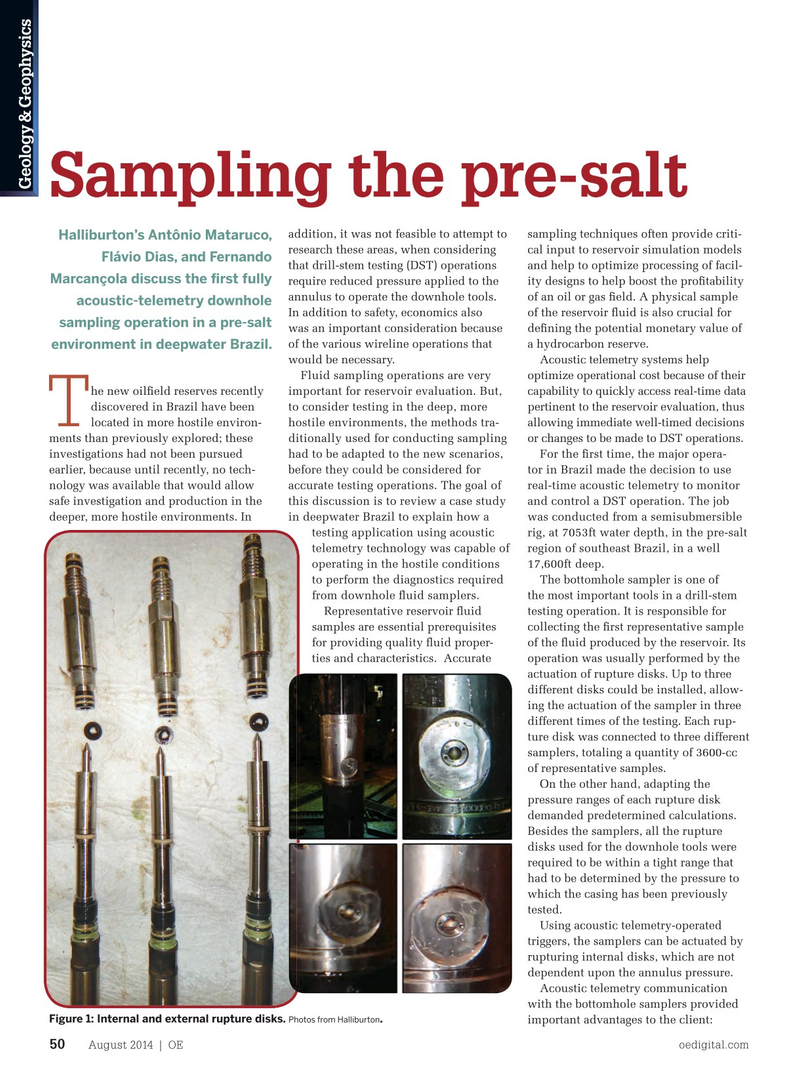
Page 48: of Offshore Engineer Magazine (Aug/Sep 2014)
Read this page in Pdf, Flash or Html5 edition of Aug/Sep 2014 Offshore Engineer Magazine
Geology & Geophysics
Sampling the pre-salt addition, it was not feasible to attempt to sampling techniques often provide criti-
Halliburton’s Antônio Mataruco, research these areas, when considering cal input to reservoir simulation models
Flávio Dias, and Fernando that drill-stem testing (DST) operations and help to optimize processing of facil-
Marcançola discuss the ? rst fully require reduced pressure applied to the ity designs to help boost the pro? tability annulus to operate the downhole tools. of an oil or gas ? eld. A physical sample acoustic-telemetry downhole
In addition to safety, economics also of the reservoir ? uid is also crucial for sampling operation in a pre-salt was an important consideration because de? ning the potential monetary value of of the various wireline operations that a hydrocarbon reserve.
environment in deepwater Brazil.
would be necessary. Acoustic telemetry systems help
Fluid sampling operations are very optimize operational cost because of their he new oil? eld reserves recently important for reservoir evaluation. But, capability to quickly access real-time data discovered in Brazil have been to consider testing in the deep, more pertinent to the reservoir evaluation, thus
T located in more hostile environ- hostile environments, the methods tra- allowing immediate well-timed decisions ments than previously explored; these ditionally used for conducting sampling or changes to be made to DST operations. investigations had not been pursued had to be adapted to the new scenarios, For the ? rst time, the major opera- earlier, because until recently, no tech- before they could be considered for tor in Brazil made the decision to use nology was available that would allow accurate testing operations. The goal of real-time acoustic telemetry to monitor safe investigation and production in the this discussion is to review a case study and control a DST operation. The job deeper, more hostile environments. In in deepwater Brazil to explain how a was conducted from a semisubmersible testing application using acoustic rig, at 7053ft water depth, in the pre-salt telemetry technology was capable of region of southeast Brazil, in a well operating in the hostile conditions 17,600ft deep. to perform the diagnostics required The bottomhole sampler is one of from downhole ? uid samplers. the most important tools in a drill-stem
Representative reservoir ? uid testing operation. It is responsible for samples are essential prerequisites collecting the ? rst representative sample for providing quality ? uid proper- of the ? uid produced by the reservoir. Its ties and characteristics. Accurate operation was usually performed by the actuation of rupture disks. Up to three different disks could be installed, allow- ing the actuation of the sampler in three different times of the testing. Each rup- ture disk was connected to three different samplers, totaling a quantity of 3600-cc of representative samples.
On the other hand, adapting the pressure ranges of each rupture disk demanded predetermined calculations.
Besides the samplers, all the rupture disks used for the downhole tools were required to be within a tight range that had to be determined by the pressure to which the casing has been previously tested.
Using acoustic telemetry-operated triggers, the samplers can be actuated by rupturing internal disks, which are not dependent upon the annulus pressure.
Acoustic telemetry communication with the bottomhole samplers provided
Figure 1: Internal and external rupture disks. .Photos from Halliburton important advantages to the client:
August 2014 | OE oedigital.com 50 050_OE0814_G&G3_Halliburton.indd 50 7/22/14 3:21 PM

 47
47

 49
49